Executive Summary
This paper was written in order to develop a marketing strategy for the Coca-Cola Amatil group (CCL). The main focus was not on the entire product line of the group but for a new product, Coke Zero. The CCL has enjoyed a lot of success for its internationally known brands such as Coke and Sprite. It however lags behind in the energy drink and sport drinks department.
Following this, it was important to develop a marketing plan that will improve the sales of Coke Zero. First, we looked at the company and the current situation it is in, both internal and external.
We noted that the company has a very good external environment that promotes investments, has good trade laws and the consumers hold the company in high esteem. We also noted that the company holds the largest market share in the country hence has consistently been making profits.
After this we took a SWOT analysis on the Coke Zero product, analysing the threats that may impede the successful performance of the product. Once the threats and weaknesses were identified, a marketing strategy was developed to improve the total sales of the product.
Strategic Analysis
Company Overview
Coca-cola Amatil is an Australian bottling company that markets products from the Coca-Cola Company. It is one of the biggest bottlers in the South-Pacific and also one the largest bottlers for the Coca-Cola company (Coca-Cola, 2010). Coca-Cola Amatil produces various products that include: carbonated soft drinks, flavoured milk, energy drinks, water, fruit juices, sport drinks and ready to eat products
The company also has a joint venture, Pacific Beverages, with SABMiller. The joint venture is responsible for producing and marketing a variety of premium beer products within the country and in New Zealand. CCL also markets and distributes spirit products for Beam Global Spirits and Wines (Coca-Cola, 2010). The Coca-Cola Company owns 30% of CCL and is thus the majority share holder of the company.
Situation Analysis-External
An analysis of the company’s current position as well as the prevailing market conditions will enable the development of a marketing plan that can be applied with respect to both the current situation as well as expected changes in the future (Kotler, 1997).
Environmental Analysis
The external environmental analysis is mainly concerned with those factors in the external macro-environment that may impact the ability of the business to meet its objectives or operate properly. The most important external elements include political, economical, social, and technological forces in the macro-environment.
The analysis of the forces is referred to as the PEST analysis. The PEST analysis looks at the different trends in the market highlighting their implications on the particular business.
Political Trends
The political and legal framework within a country usually affects how a business operates and its profitability (Payne, 2005). Coca-Cola Amatil operates in countries that have stable political systems as well as favourable trade laws that encourage business growth. The products that the company produces have all been approved by the relevant food licensing board in the country.
Economic Trends
Australia has enjoyed a stable economic growth over the ages. The country has been ranked as the 13th largest economy in the world and the 18th largest exporter (Dixon & O’Mahoney). The country has enjoyed a steady growth at the rate of 3.6% over the last 16 years.
The unemployment rate in the country stands at 4.9% and the inflation rate as per last year was 2.8% (Dixon & O’Mahoney, 2010). According to the World Bank, Australia is ranked tenth on the ease of doing business. The base interest rate in the country stands at between 5 to 6%.
Social Trends
Over the years, there has been a health consciousness campaign warning people about over consumption of soft drinks. Various groups have frequently warned people that soft drinks are responsible for increase in obesity and other issues such as diabetes and rotting of teeth.
Australia is also fascinated by sports. A survey on sporting claims that over 80% of young men are participate in sports in one way or another. Considering this, sport and energy drinks might increase in sales if sufficient marketing is carried out to penetrate the sports industry
Technological Factors
Australia is a developed country whose main revenue comes from the manufacturing industry. The company has many professionals who engage in the development of new and innovative technological products (Svenson, 2009). The country also has many research facilities and those professionals seeking to undertake research are sponsored by the government, corporations and educational institutions.
Market Analysis
The soft drinks market in Australia is predominantly controlled by four main companies. These companies include; Coca-Cola Amatil, Nestle Australia, Cadbury Australia and Mars Australia.
The Coca-Cola Amatil group holds about 56% of the market share in the non-alcoholic beverages, 40% market share in sports drink and 23% market share in bottled water (Greenblat, 2010). In market analysis, it is important to analyse the consumers, competitors, and carry out the five force analysis.
Consumer Analysis
Coca-cola products are usually enjoyed by people from all age groups. It has however been noted that a large percentage of people who consume products from CCL are those in the 16-32 age group making up 52% of the total consumers.
The buying behaviour is mainly guided by attitudes and lifestyle of these consumers. The introduction of new products by the company usually receives positive reception while consumer satisfaction for our products has been generally high.
Porter five forces analysis
It is important to analyse the business micro environment in order to present a valid business marketing strategy. The Porter five forces are those forces that affect the ability of a corporation to make a profit or serve its consumers (Simon, 2006). The Porters five force analysis for CCL is shown in Fig 1
Figure 1: Porters Five Force Analysis for the soft drink environment
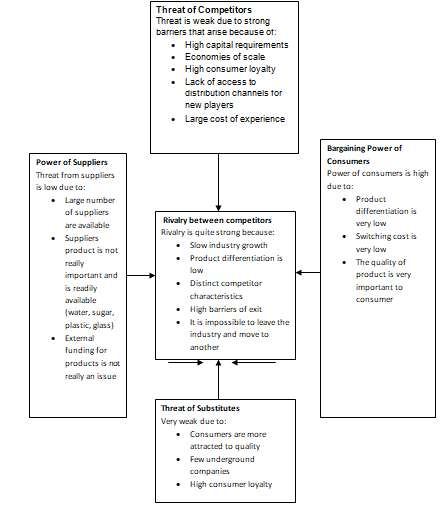
Success factors
From the external environmental analysis, the following key success factors can be identified
- The political, economical, social and technological trends all favour the success of CCL’s products
- The company holds a large percentage of the market share with the soft drink market
- The threat of new entrants into the industry is small
- The company mainly supplies most of its products and has a large network of suppliers hence threat of suppliers is small
Situation Analysis (Internal)
The internal situation analysis involves those factors within the company that affects its ability to operate and earn a profit. It includes the company resources, the objectives, corporate culture and mission (Williams & Williams, 2007).
Review of Current Strategy and marketing mix
Coca-Cola Amatil current strategy involves availing beverages to people all over the country and the other four countries that the company operates. The company does this by setting up a network of partners, acquiring new business, participating in the marketing and distribution of other beverages such as alcohol and by using various strategies to improve its marketing of products.
Coca-Cola Amatil marketing strategy includes the use of advertisements, sports sponsorship deals, games and competitions and the use of the internet to promote its products. The current marketing mix can be well represented by the four P’s:
- Product: Coca-Cola Amatil produces a variety of non-alcoholic drinks as well as alcoholic drinks. The products include both internationally known brands and brands specifically produced for the country. Products include soft drinks, energy drinks, water, sports drinks, RTD tea and coffee, ready to eat fruits and flavoured milk. Product differentiation in most of these products is low hence there is a need for a unique product to retain competitiveness.
- Price: The current price for CCL products is low and very competitive. A large population can easily afford these products on a regular basis.
- Promotion: CCL’s products are promoted through advertising and sales promotion. The strong brand name of the company has also propagated promotion of their products
- Place: CCL’s products can be purchased from many outlets all over the country. Supermarkets, shops, drink stands, gymnasiums and other local outlets usually have Coca-Cola products.
Performance and Financial analysis
Over the past years, the company has had significant success and has made a lot of profit. The company has had a one digit increase in profits for the last 10 years. Despite the economic recession, the company still had an increase in profit during the period. In 2010, the company had a net profit of $497.3 million, representing a 10% increase in profit from the previous year.
The trading revenue for the year stood at $4490.3 million while the operating cash flow totalled $585.5 Million decreasing by 22% since the last year. The earnings before tax (EBIT) for the company were $844.9 showing a 7.3% increase from that in the previous year (Coca-Cola, 2010).
The company stock as of 2010 stood at $11.60 and has been showing a steady growth. As it can be seen, the company is in a very strong financial position and stands to gain more competitive advantage with the right marketing strategy.
Table 1: Financial Analysis
Resource Analysis
Resource analysis involves the analysis of how the company’s resources and capabilities enable it to achieve its strategy (Schwartz, 1981). The resource analysis for the company is presented in Figure 2.
Figure 2: Summary of the Coca-Cola Amatil resource analysis
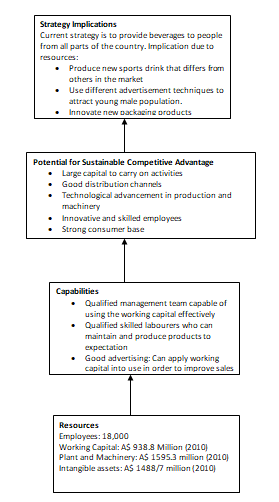
Determinants for strategic options
Strategic marketing options may be constrained by both internal and external situations. In the case of Coca-Cola Amatil, determinants for strategic options include:
- Optimum utilization of the large amount of available capital
- Differentiation of products, producing a new product that differentiates it from its competitors
- Improving its promotional campaign; this involves increasing efforts in public relations and personal selling
SWOT Analysis
The SWOT analysis involves a look at the company’s current position in respect to its competitors, market conditions, consumers, suppliers and government regulations (Pepall, Daniel & Norman, 2005). The SWOT analysis will look at the situational factors affecting the business.
Strengths
- Strong financial position enabling future investments
- Strong distribution channels that may reach consumers and suppliers from all over the country
- Strong brand name that is easily recognized thereby improving consumer confidence
Weaknesses
- The product is very new to the market and thus sufficient information about consumer demand is yet inconclusive. Without proper marketing strategy, the product might fail.
Opportunities
- The Coca-Cola brand name is widely known and revered. This will therefore boost consumer confidence about the product thereby improving sales.
- The new product (Coke Zero) also does not have any competition in the market as per this moment. The low diet drink that target young males as for now is unique as it deviates from other diet drinks and will therefore gain significant market share.
Threats
- The internationally recognized brands are still etched in the minds of people hence a large group may ignore the new product and stick to that which they are familiar with.
- The Coke Zero product has also received negative reviews in some countries. This is because in several countries such as Venezuela, Sodium cyclamate a known carcinogen was used as a sweetener.
- Health concerns over consumption of soft drinks.
Strategy Development
This section deals with developing a marketing strategy that will enable the company to meet strategic marketing goals. The company has several sustainable competitive advantages which include:
- The Coca-Cola brand is very strong hence improving consumer confidence
- The company has a strong distribution channel that spans five countries
- The company is part of a global conglomerate therefore has access to top notch equipments, professionals and assets
- The company produces its own packaging hence can modify it with any problem
- The company already has a fierce reputation hence does not need to begin from the bottom in its promotional activities.
Strategic Thrusts
The Coca-Cola Amatil group main business strategy is to produce beverages for everyone in the country. The company strategic thrusts are as follows:
- Produce a variety of products to account for taste, preferences and lifestyles.
- Engage in intensive promotional activities through advertisement, sales promotion, personal selling and public relations
- Acquire new holding and business
- Penetrate other beverage industries such as alcoholic drinks and RTD drinks.
According to Ansoff, for a company to be successful it should choose one of three generic strategies: cost leadership, differentiation or niche strategies In order to be truly sustainable and to maintain competitive advantage, the company has to implement alternative competitive thrusts that include:
- Production of a new sports drink that offers something other sports drinks lack (differentiation).
- Restricting access to distribution channels for the other competitors (niche strategies).
- Reducing cost of production by using innovative techniques of management and production (cost leadership)
Sustainable Strategic Thrust
Considering the initial and alternative strategic thrusts, the most appropriate thrust has to be the production of a new sports drink that is not available in the market. CCL should produce a healthy sports drink with very little calories, has high levels of proteins and vitamins and rejuvenate those participating in sports and the general population. This will not only target the young male population but also sportsmen and women.
Marketing Goals
The main marketing goals involve improving sales for the coke zero products. The goals are:
- Improve the sales of sports drink by 8%
- Attract more consumers (especially the young male population)
- Infiltrate the sports Industry
- Improve the market share in sports drink by at least 4.5%
Product-Market investment Strategies
Coca-Cola Amatil main products have performed very well in the market over the years. Most of the products are well known and are a major part in people’s diets. When Coke Diet was produced, most men felt that it was geared for women. It was for this fact that coke zero was made and was mainly meant to penetrate the young male market.
The diagram below is a presentation of the Ansoff’s Matrix for Coca-Cola Amatil:
Figure 3: Ansoff’s Matrix
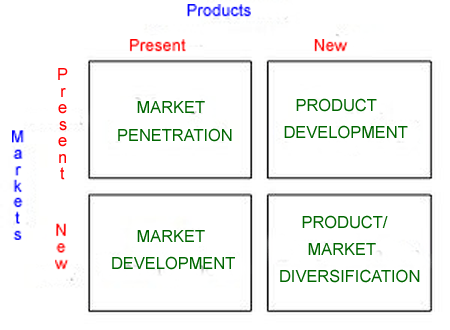
Retrieved from Sharp & Dawes (2001)
Market Penetration
The CCL’s sports drink market currently lags behind its competitors. In order to improve its market share, the company should engage in large scale promotion activities that include sponsorship deals, competitions, advertisements and personal selling mainly through the internet.
Market Development
One of the main reasons CCL has not been able to capitalize on the young male population is that the sports drinks in the market are all similar and no healthy drink exists as of now. The Coke Diet beverage launched by CCL was largely viewed as feminine and most men ignored it. Coca-Cola has been able to modify this drink to produce Coke Zero, a diet drink that is geared to the male generation.
Product Development
In recent times, the soft drink industry has been growing slowly mainly due to health concerns that have arisen about the consumption of soft drinks. It is therefore important to develop a new product that is not only health but also delivers the expected results.
CCL has dominated the soft drinks market hence it should put more of its energy in the sports drink market. The intended product should be rich in proteins and vitamins as well as rejuvenating compounds that are common in energy drinks. The drink should also reduce the amount of calories present in the drink
Product Differentiation
The current products targeting the young male population are all similar. Due to health concerns, the soft drink industry growing very slowly. In order to maintain competitiveness, CCL should therefore develop a new product that differs from those in the market and meet the health expectations of the consumers.
Another way will be through the development of a new innovative packaging. A coke zero grip bottle that has been innovatively design will be used to package the product and thus attract more of the targeted consumers.
Strategic Marketing Mix
The marketing strategy mainly involves targeting and positioning (Aaker, 2007). According to research, over 80% of young men above the age of twenty participate in sports one way or another. This number is very high and may increase the market share for coca-cola products immensely.
We shall first target sportsmen by highlighting that the company has a new range of sports drinks (coke zero) that not only meet the sports drinks requirement but is also healthy.
Products
The product being marketed is a new healthy beverage, a sports drink mainly produced for the young male population (coke zero). The product has very little calorie content and is high in vitamins and proteins. This combination makes for the ideal sports drink as it not only rejuvenates a person but it is also healthy.
The product will be packaged in trendy bottles that convey sportsmanship. The marketing message will try to stress that the drink is healthy and is a new innovation all our competitors envy (Sharp & Dawes, 2001).
Price
The product will be cheap to buy and will generally cost less than those from our competitors. It will be available in most outlets throughout the country and stands in the stadiums. The pricing will be such that the company does not undergo a loss but low enough to make the product the drink of preference (Sharp & Dawes, 2001).
Place
The drink will target the whole of the country. It will be available in supermarkets, shops, stadiums and gymnasium. In order to access the sports fraternity, the drink will mainly focus on sports related outlets until it stands out as the drink for the active sportsman (Sharp & Dawes, 2001).
Promotion
As the drink mainly targets young men interested in sports, the drink will first of all be promoted through sports channels, and stadium advertisements such as banners and Advertisement slots in the stadium. Next, sports paraphernalia will be used as a means for promotion such as balls, t-shirts, shoes etc.
The drink will also be promoted through competitions in radio stations and television. The promotion will have a sports team e.g. granting a lucky winner sports gear or a fully paid access to an important sports event (Sharp & Dawes, 2001).
Sales Forecast and Financial Prediction
We expect that after this marketing strategy, sales will increase by 6% in the first quarter and that by the end of the year a 10% increase will have been achieved.
Table 1: Financial Prediction
Evaluation and Control
The article above has presented the strategic market plan for the Coca-Cola Amatil group. The sales target presented above will act as benchmarks to evaluate progress. The marketing techniques recommended (sports advertisements and sports related sales promotions) will be amended depending on the nature of the actual sales.
The Coca-Cola company has enough capital to implement the program successfully hence the products will be released in all regions within a period of 2 weeks. The company have a large distribution channels with many trusted partners hence control is not a major concern as of now.
Appendix
Appendix 1: Income statement CCL retrieved from Coca-Cola Amatil (2011)
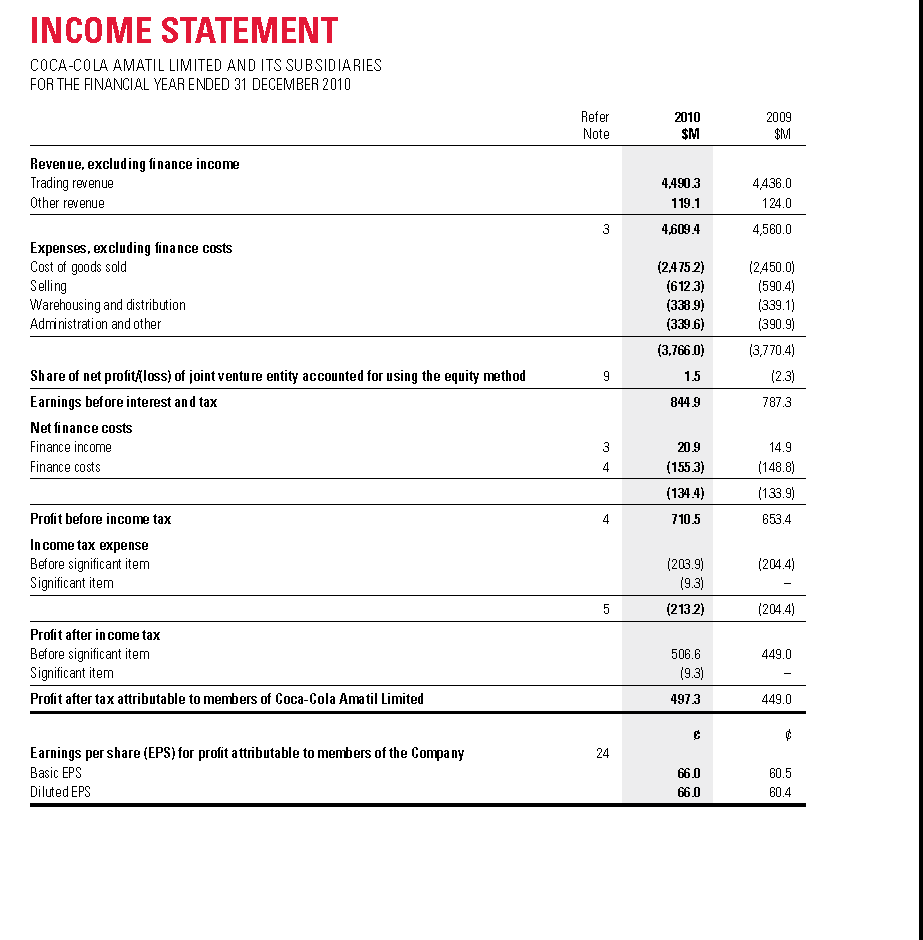
Appendix 2: Balance Sheet retrieved from Coca-Cola Amatil (2011)
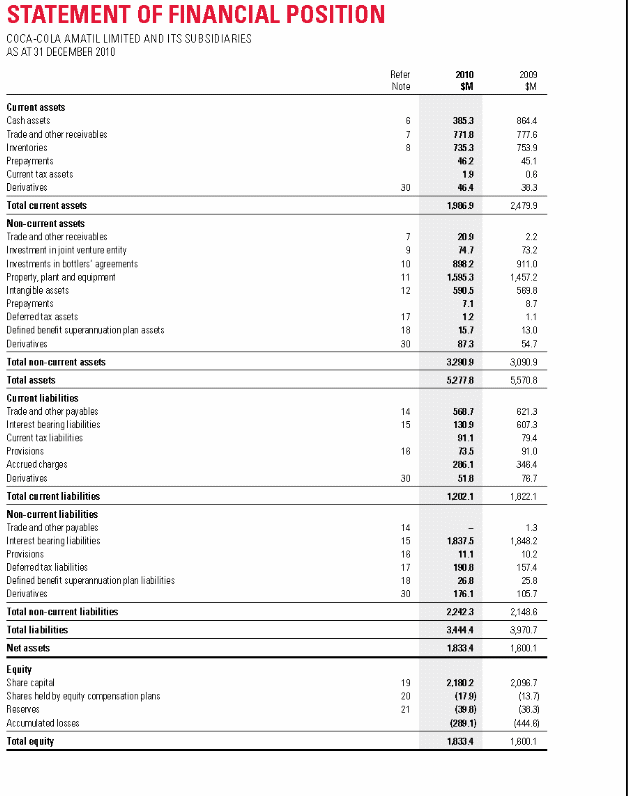
References
Aaker, D. (2007). Strategic Market Management, 8th ed. New York, John Wiley & Sons
Coca-Cola (2011). Annual Report 2010. Retrieved from: www.ccamatil.comreportsF9ECBDFAd01.pdf
Dixon, T & O’Mahoney, J. (2010). Australia in the Global Economy 2010. Pearson: Leading Edge Education
Greenblat, E. (2010). Coca-Cola Amatil beats profit estimates as prices rise. SMH Newspaper. Retrieved from: www.smh.com.au/business/cocacola-amatil-beats-profit-estimates-as-prices-rise
Kotler, P. (2009). Principles of Marketing. New York: Prentice Hall.
Payne, A. (2005). A Strategic Framework for Customer Relationship Management. American marketing association, 69: 168-170
Pepall, L., Daniel J. & Norman, J. (2005). Industrial Organization, Contemporary Theory and Practice. Ohio: Thomson South-Western
Porter, M.E. (1985) The Five Competitive Forces That Shape Strategy. Harvard business Review, (4): 12-16-January
Schwartz, H. (1981). Matching corporate culture and business strategy. Organization Dynamic, 24(2): 12-16
Sharp, B. & Dawes, J. (2001). What is Differentiation and How Does it Work? Journal of Marketing Management, 17, 739-59.
Simon, H. (2006). Rational decision making in business organizations. American Economic Review, 17(5): 42-45
Svenson, G. (2009). Globalization” of business activities: a “global strategy” approach. Management Decision, 7(13): 34-40
Williams, S. & Williams, N. (2007). The profit impact of business intelligence. NY: Publisher Morgan Kaufmann